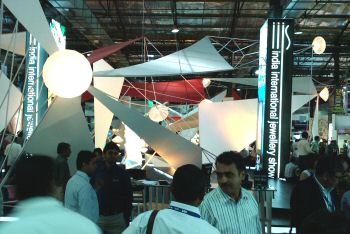IIJS Proves That India Has Come of Age
August 24, 10
 |
The India International Jewellery Show (IIJS) was packed with buyers that were there to do business, not just browse. From loose polished diamonds and gems, through gold and diamond jewelry to full marketing packages, exhibitors offered a wide range of wares, ready to meet most needs.
After days of preparations and collecting goods in the market, on the eve of the show opening traders in Mumbai were hesitant about the show. They were concerned that the show may not be the great success that they hoped for. They were wrong.
The first day of the show, while many exhibitors were putting the final touches on their booths, international buyers uninhibited by the long lines outside of the exhibition halls quickly searched for the booth that offered what they were looking for and set down to do business.
The following days, however were dominated by domestic buyers, Indian jewelry wholesalers and retailers from 200 of the sub-continents largest cities. At the same time, several exhibitors said that they would have liked to see more international buyers, specifically from the U.S. and Europe.
The dominance of the local market cannot be understated. Large diamond firms that in the past sold mostly overseas are seeing a growing portion of their sales shifting to India. In some cases, the majority of their sales are now local. Even boutique jewelry makers such as Diamour that sold only abroad had a booth at the show with the intention to add domestic clients.
Diamond manufacturers reported strong demand for GHI / VVS-VS goods. Most buyers of these items wanted triple excellent make but found that sellers are not willing to lower their prices to meet their budget. As a result, very good makes sold well.
Besides price, traders bumped into two barriers. Many of the jewelry buyers wanted to pay in cash and keep the transactions off the books. While this may have proved tempting for some companies, many others, mostly large firms, said they could not do make such sales.
Another issue diamond wholesalers found when dealing with store owners was the preference for ready jewelry over loose diamonds. Some noted that this was a shift, as store owners until now preferred to rely exclusively on their own craftsmen for jewelry making. Large companies that don’t have jewelry operations, such as Rosy Blue, found this to be an obstacle.
Another new trend that emerged was the willingness of diamond traders to offer memo goods to jewelers. Jay Parikh of Ketan Brothers voiced concern that the type of fallout suffered in the U.S. may harm diamantaires in India as well.
Some dealers will give out goods for only a couple of days so retailers can show them to a prospective client, however some wholesalers are offering three month memos to retailers.
The show ended with one sour note. A gang of four Mexican nationals succeeded to steal from Dalumi goods estimated at $1.45 million as the show was closing and the team was busy packing their booth.
Coupled with the first International Jewellery Week (IIJW), the Gem & Jewellery Export Promotion Council (GJEPC) offered a wide range of opportunities to the global industry - high-end “couture” jewelry on the runway, seminars on a wide range of subjects and a vibrant trading arena - proving that India is far from being a budding, developing market. It is a fully developed, vivacious market.